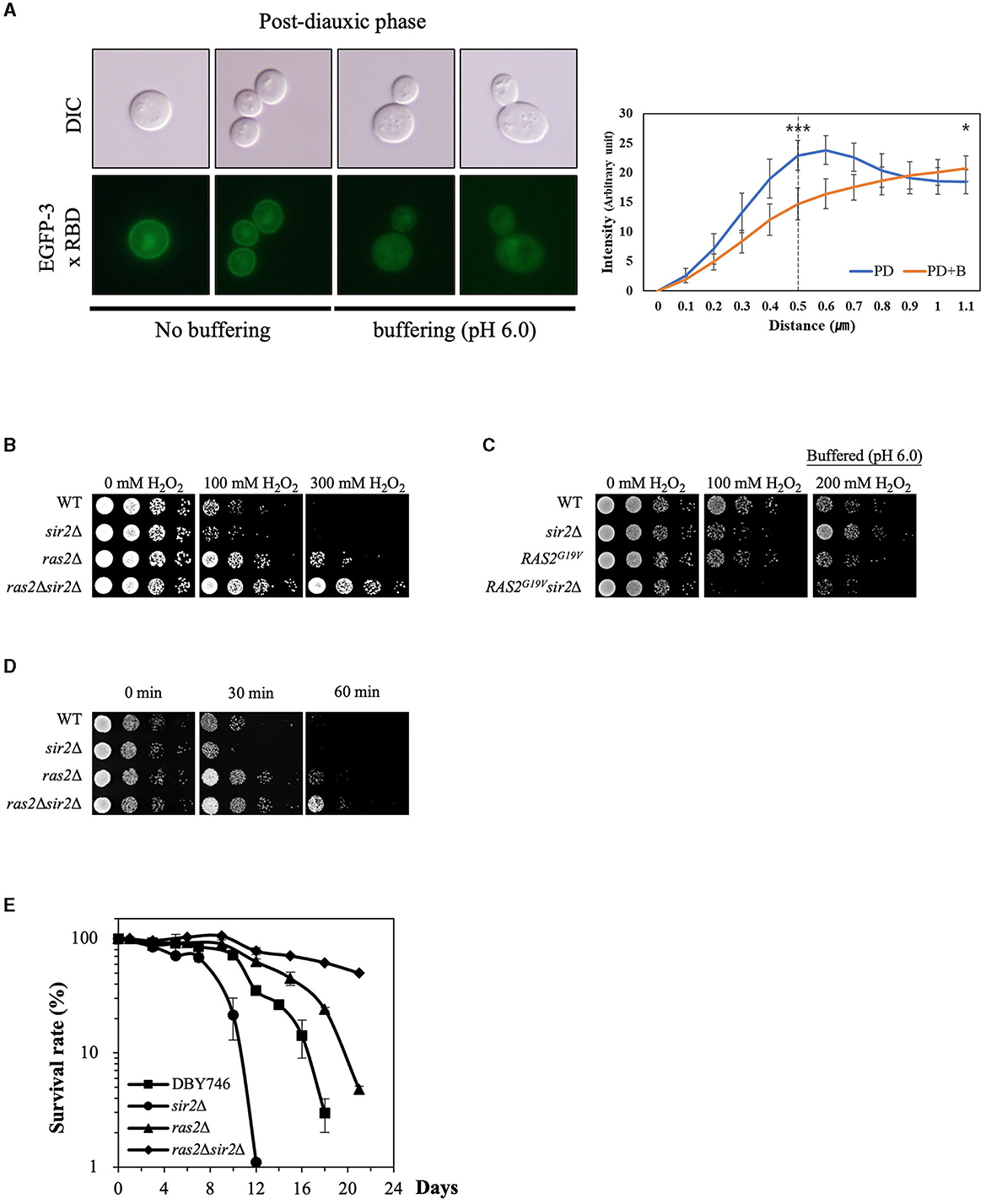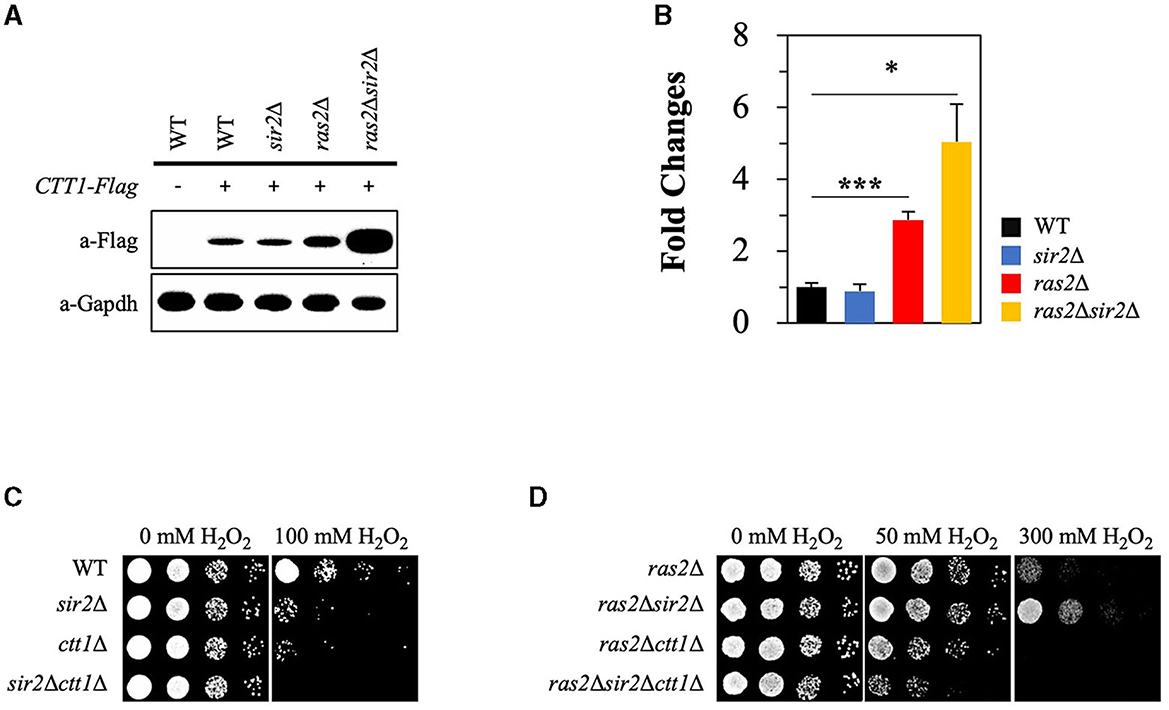The intricate role of Sir2 in oxidative stress response during the post-diauxic phase in Saccharomyces cerevisiae
- Department of Microbiology and Molecular Biology, College of Bioscience and Biotechnology, Chungnam National University, Daejeon, Republic of Korea
A corrigendum on
The intricate role of Sir2 in oxidative stress response during the post-diauxic phase in Saccharomyces cerevisiae
by Kim, Y. H., Ryu, J.-I., Devare, M. N., Jung, J., and Kim, J.-Y. (2023). Front. Microbiol. 14:1285559. doi: 10.3389/fmicb.2023.1285559
In the published article, there was an error in Figure 4C and its caption. The constitutively active form of RAS2 was incorrectly labelled as “RAS2Q19V”. The correct expression is “RAS2G19V”.
The corrected Figure 4C and its revised caption appear below.

Figure 4. Ras2 activity is involved in the altered effect of SIR2 deletion on H2O2 resistance during post-diauxic growth phases. (A) (Left panel) Ras2 activity was analyzed using EGFP-3x RBD in the wild-type strains treated with or without buffer (pH 6.0). (Right panel) The fluorescence intensity was assessed using ImageJ and expressed in arbitrary units (n = 10 cells for each strain). The distance is measured starting from a point outside the cell and traversing through the cell membrane. The dotted line at 0.5 μm serves as indicator of the approximate boundary between the interior and exterior of the membrane. p-values were calculated using a t-test (*p < 0.05 and ***p < 0.005). (B) H2O2 resistance was evaluated in the wild-type, sir2Δ, ras2Δ, and ras2Δsir2Δ cells during the post-diauxic phase. (C) H2O2 resistance was tested in the wild-type, sir2Δ, RAS2G19V, and RAS2G19Vsir2Δ strains during the post-diauxic phase. Note that RAS2G19V is a constitutively active form of RAS2. (D) Heat stress resistance was evaluated in the wild-type, sir2Δ, ras2Δ, and ras2Δsir2Δ cells during the post-diauxic phase. (E) The chronological lifespan of the wild-type, sir2Δ, ras2Δ, and ras2Δsir2Δ strains grown in YPD medium was monitored by counting colony-forming units every 2 or 3 days. Experiments were repeated three times. Error bars indicate the mean ± SD.
In the published article, there was an error in Figure 5B as published. Three asterisks (*) were used to denote p < 0.05. This has been corrected to one asterisk. There was an error in the caption for Figure 5. The types “ctt11Δ” and “ras2Δctt11Δ” were incorrectly used. The correct expressions are “ctt1Δ” “ras2Δctt1Δ”.
The corrected Figure 5B and its caption appear below.

Figure 5. Sir2 affects the expression of CTT1 in the absence of Ras2 but not in its presence. (A) Ctt1 protein levels in the wild-type, sir2Δ, ras2Δ, and ras2Δsir2Δ strains were measured by western blot. GAPDH was used as a loading control. (B) qRT-PCR was performed to assess CTT1 mRNA levels in the wild-type, sir2Δ, ras2Δ, and ras2Δsir2Δ. The data represent the average of at least three independent experiments (±SD), and p-values were calculated using a t-test (*p < 0.05 and ***p < 0.005). (C) H2O2 resistance was tested in the wild-type, sir2Δ, ctt1Δ, and sir2Δctt1Δ strains. (D) H2O2 resistance was also tested in the ras2Δ, ras2Δsir2Δ, ras2Δctt1Δ, and ras2Δsir2Δctt1Δ strains during the post-diauxic phase.
In the published article, there was an error in Results, “Ras2 is responsible for different responses to H2O2 stress during the post-diauxic phase”, paragraph 2, lines 8–10.
This sentence previously stated:
“In addition, we found that the expression of a constitutively active form of RAS2 (RAS2Q19V) increased the sensitivity of the sir2Δ cells to H2O2 stress (Figure 4C).”
The corrected sentence appears below:
“In addition, we found that the expression of a constitutively active form of RAS2 (RAS2G19V) increased the sensitivity of the sir2Δ cells to H2O2 stress (Figure 4C).”
The authors apologize for these errors and state that they do not change the scientific conclusions of the article in any way. The original article has been updated.
Publisher's note
All claims expressed in this article are solely those of the authors and do not necessarily represent those of their affiliated organizations, or those of the publisher, the editors and the reviewers. Any product that may be evaluated in this article, or claim that may be made by its manufacturer, is not guaranteed or endorsed by the publisher.
Keywords: Saccharomyces cerevisiae, Sir2, oxidative stress, Ras2, cytosolic pH, Azf1
Citation: Kim YH, Ryu J-I, Devare MN, Jung J and Kim J-Y (2024) Corrigendum: The intricate role of Sir2 in oxidative stress response during the post-diauxic phase in Saccharomyces cerevisiae. Front. Microbiol. 14:1357693. doi: 10.3389/fmicb.2023.1357693
Received: 18 December 2023; Accepted: 19 December 2023;
Published: 08 January 2024.
Approved by:
Frontiers Editorial Office, Frontiers Media SA, SwitzerlandCopyright © 2024 Kim, Ryu, Devare, Jung and Kim. This is an open-access article distributed under the terms of the Creative Commons Attribution License (CC BY). The use, distribution or reproduction in other forums is permitted, provided the original author(s) and the copyright owner(s) are credited and that the original publication in this journal is cited, in accordance with accepted academic practice. No use, distribution or reproduction is permitted which does not comply with these terms.
*Correspondence: Jeong-Yoon Kim, anlraW1AY251LmFjLmty
†These authors have contributed equally to this work
 Yeong Hyeock Kim
Yeong Hyeock Kim Ji-In Ryu
Ji-In Ryu Mayur Nimbadas Devare
Mayur Nimbadas Devare Juhye Jung
Juhye Jung Jeong-Yoon Kim
Jeong-Yoon Kim